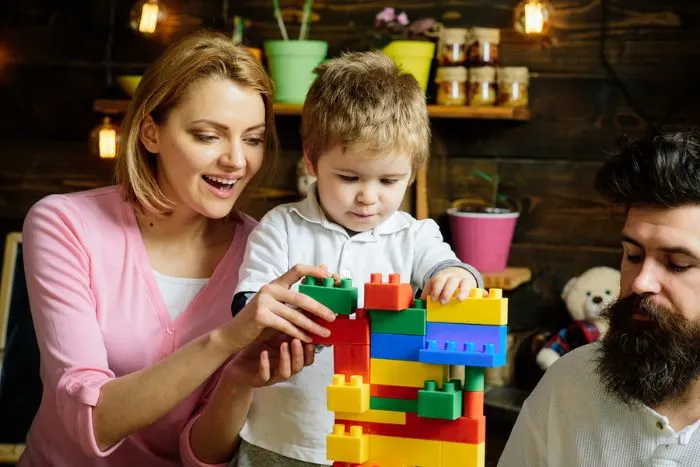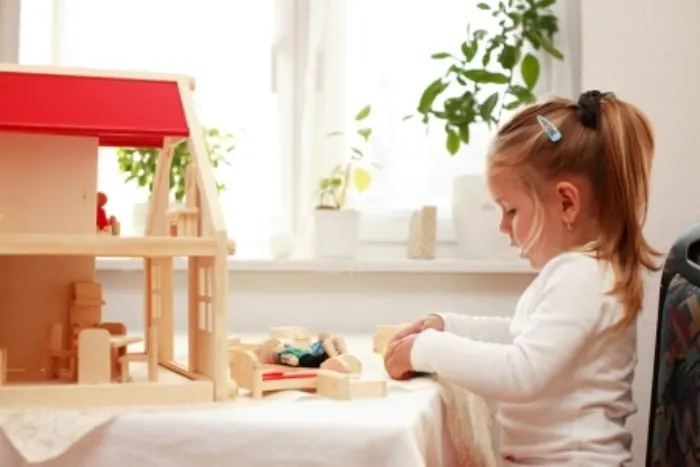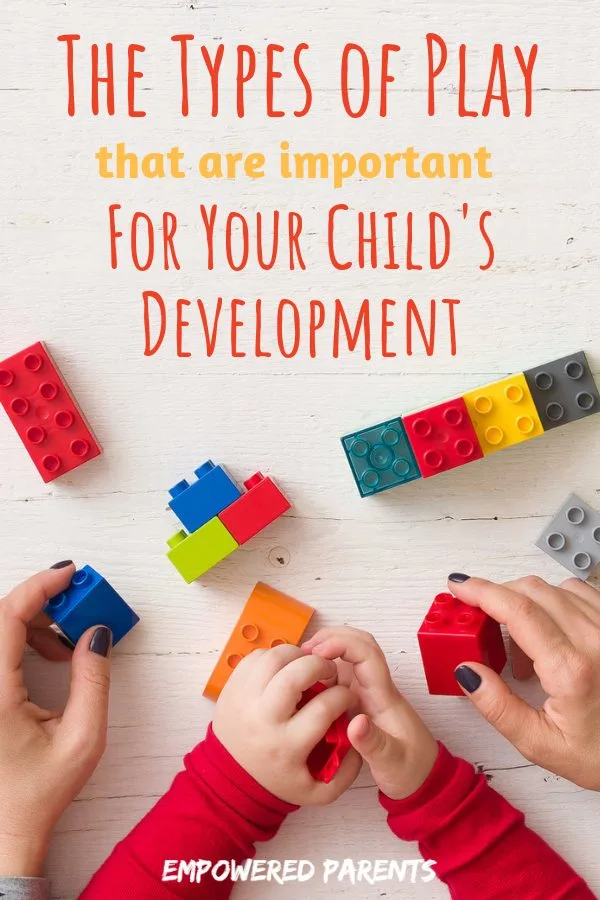What is play and why are the different types of play and stages so important for a child’s overall development?
Play is the medium through which children explore and experience their world. A child’s overall physical, emotional, cognitive and social development depends on play.
Some characteristics of play:
- Play is intrinsically motivated and spontaneous
- It is focused on the process rather than the product
- Play is carried out as if the activity were “real” and driven by imagination
- It is mostly free of externally imposed rules
- It is done merely for enjoyment
Children learn to understand the world and how it works through play. Their experience of reality is reflected through play.
During play children are:
- Thinking
- Solving problems
- Developing memory
- Planning and investigating
- Developing language skills
- Concentrating
- And learning many more skills…
How Many Types of Play Are There?
It is difficult to say the exact number as many types of play have been identified by various child development theorists.
There is a difference, however, between stages of play and types of play.
The stages of play are based on the level of social interaction during play (such as solitary or social play) or on the main characteristic of play (such as symbolic play or play that involves games with rules).
The types of play are based on the specific type of activity involved such as language play or constructive play).
There are roughly 3-5 general stages of play that have been identified, but many more types of play. These are all explained below.
All types of play are important and, although children progress naturally through stages, they tend to add and integrate some types of play, rather than stop one type and start a new type.

In the book “The Young Child in Context: A psycho-social perspective“, Marike de Witt has a comprehensive list of the various theorists and the types of play they identified. Here’s a brief summary.
Solitary Play
Mildred Parten identified four main social stages of play – solitary, parallel, associative and cooperative play
During the first stage, known as solitary play (or non-social play), children play with toys on their own and do not notice or concern themselves with other children or what they are doing.
Parallel Play
When children engage in parallel play (Parten’s second stage of play), they may play with similar toys such as building blocks, but they are playing next to each other rather than together.
They are not interacting but are happy to be playing near another child.
Children also engage in onlooker play, where they watch the other child play but do not join in or play themselves.
Associative Play
During associative play (Parten’s third stage of play), a pair or small group of children play together, but with little cooperation and negotiation.
They share toys but are each playing their own game and not working towards a shared goal.
Cooperative Play
Cooperative play (Parten’s fourth stage of play) may include a game with rules or a shared goal, such as building a tower together. Children plan, negotiate and assign roles as they play.
Practice Play
Jean Piaget identified three stages of play – practice play, symbolic play and games with rules.
Practice play is about exploring materials and toys to “see what they do.” It involves simple, repetitive movements, sometimes also without toys.
Some theorists also refer to unoccupied play, which tends to be comprised of random movements without a clear purpose, although it is still a part of play.
Symbolic Play
Piaget’s second stage of play, called Symbolic play, is when children use an object, action or idea to represent something.
They could use a block, for example, to pretend they are on a telephone call.
Games with Rules
The last stage of play according to Piaget is more structured and requires following rules and norms to reach a goal when playing alone or with a group.
Sara Smilansky’s four stages are similar to Piaget’s stages above – functional (similar to practice play), constructive, dramatic (similar to symbolic play) and games with rules (same).
Constructive Play
Smilansky described constructive play as the stage in which children manipulate objects in order to create something.

Examples would be stacking blocks, building a fort or making a machine with cardboard boxes.
The following types of play were noted by various theorists, depending on the angle from which they studied play. These categories are based on the characteristics of the play or on how they develop the child.
The types of play that follow are more categories, added by researchers such as Garvey, Sarafino and Armstrong.
Ritual Play
This is the rhythmic repeating of sounds or words. Young children do it purely for enjoyment and often use exaggerated body movements.
Language Play
This kind of play involves making up nonsense words and rhyming words. It starts before a child learns to converse.
Fantasy Play
Also known as pretend play, dramatic play or make-believe play, this form of play involves “acting out” ideas using objects and carrying out roles.

An example of fantasy/pretend play would be dressing up and pretending to be firemen or playing shop.
Symbolic play, where objects are used to represent things, is also a type of fantasy play.
Sensory-Stimulating Play
Sensory play involves stimulating the senses and experiencing sounds, rhythms, tastes, textures, smells, colours, shapes and movements.
Babies, for example, want to touch everything or place objects in their mouths.
Investigative (Exploratory) Play
At this stage, the child wants to see what happens when materials are manipulated. An example would be moving on from tasting blocks to stacking them (as they move through the stages of block play) and seeing what happens.
Competitive Play
This refers to games with rules and rituals. Children’s play becomes more structured at this stage and may involve multiple players.
Physical (Motor) Play
This refers to play that is purely physical in nature, such as skipping, climbing a jungle gym or riding a tricycle.
Expressive (Creative) Play
Expressive play is about creating art, music or even writing to express one’s creativity.
Why is Play Important for Development?
The role of parents and teachers is to set the stage for children’s holistic development. The best way to do this is to encourage and make opportunities for regular play.

There are benefits of different types of play in early childhood and parents can, therefore, encourage a variety of play experiences as well as different types of play materials.
Play develops the whole child. There are four main areas of development:
- Physical
- Cognitive (Intellectual)
- Emotional
- Social
Through play, each of these areas are stimulated and developed right from birth and through the early childhood years.
Here is an overview of how your child grows and develops through play. Some of these benefits of play are listed in the book mentioned above by Marike de Witt.
Physical
Physical activity is important for developing motor skills and when a child plays it is often physical. Play develops a child’s sensorimotor skills and allows a release of energy too. The following areas are developed through play:
- Muscle tone and development
- Fine motor skills
- Fluidity of movements
- Specific gross motor skills such as ball skills, hopping, etc.
- Health and fitness
- Developing the senses
- Coordination and balance
- Physical strength
Cognitive
Play is responsible for building a child’s intellectual ability. Through play children learn:
- Concepts
- Concentration
- Creativity
- Thinking skills such as sorting, classifying, etc.
- Knowledge
- Language and communication
- Problem solving
- Memory
- Perceptual skills
- Listening skills
Emotional
Emotional development is as important as physical or intellectual development. Children gain emotional intelligence through play and learn about themselves and their feelings. Play usually is a positive experience, through which a child learns:
- Self-confidence
- Trust
- Expressing feelings in a healthy way
- Understanding his positive and negative emotions
- Self-control
- Competence (through success at play)
- Facing conflicts and fears
Social
Play is a social activity and the main way children pick up social skills and learn to interact with their parents, families and peers. Children learn about:
- Appropriate social norms
- Cooperation – sharing and taking turns
- Conflict resolution
- Empathy and sympathy
- Leading and following
- Social language skills
- Rules and responsibilities
- Participating in a group
- Respecting others’ possessions
Examples of Play During the First 9 Years
Here is a brief list showing typical play during the various stages of childhood, as shown in the book “The Young Child in Context: A psycho-social perspective“, by Marike de Witt.
They are rough guidelines and may vary slightly from child to child.
Babies
- Oral activities – breastfeed and make other lip movements
- Make and listen to sounds
- Play with breath and saliva
- Do mouth exercises
- Play with body parts, mother’s hair, buttons, etc.
- Play games such as “Where are you? There you are!”
- Play with objects
Toddlers
- Imitate their mother
- Explore their own and their mother’s body
- Start playing hide-and-seek games
- Pick up and drop, stack and bash down, fill and empty
- Experiment with movement
- Start fantasy play e.g. with stuffed animals
3-Year-Olds
- Collect objects
- Engage in sensorimotor activities
- Imitate affection that is modelled in the family, towards people and objects
- Show some aggression in play e.g. imitating a superhero (fantasy becomes reality)
- Play games about disappearing and reappearing
- May follow a play ritual for security e.g. building a puzzle when dropped off at school each day
- Roleplay (e.g. pretending to be a parent or an animal)
4-Year-Olds
- Express aggression through games (e.g. superheroes, chasing monster games, hiding from “bad” guys)
- Play hide-and-seek and hiding/burying games
- Have a better understanding of fantasy and reality (e.g. pretends to be a bear or plays with a toy bear, does not think he is one)
- Fantasy play includes broader topics outside the home and family e.g. the fire station
- Doctor-nurse type games arise from body curiosity
- Male and female gender roles are emphasized in play
- Socialize more with others
- Love to dress up
- Test physical skills in games
5-Year-Olds
- Often play games referred to above, or begin playing games with rules
- Engage in fantasy play, but with a clear understanding of fantasy and reality
- Act out stressful situations or feelings of anxiety through play
- Roleplay becomes more intricate and can also be carried out through puppet shows or staged stories
- A fascination with romance begins through chasing girls/boys or acting out weddings or fairy tales
6-9-Year-Olds
- Fantasy play can continue past the age of 9 but is more elaborate and the same plot may continue over several days
- Play can be gory and dramatic
- Need frequent physical play and have boundless energy
- More advanced play such as skating or ball games – can participate in team sports
- Romance is joked about
- Themes such as bravery, injuries and attractiveness emerge in play
Parents’ and Teachers’ Role in Play
Often, an adult’s role in children’s playtime is just to be present. At other times, it is to intervene and provide opportunities or support learning through play.

When young toddlers play they will often feel more secure knowing their parent is nearby. As they grow older, they will rely on a teacher’s presence at school and later on will not need this security anymore.
Here are some tips for how to best support children through play, according to Joanne Hendrick, author of the book “Total Learning: Developmental Curriculum for the Young Child“.
- Ensure age-appropriate activities
- Allow sufficient time for play every day, indoors and especially outdoors
- Set up a safe environment in order to minimize constantly saying “no”
- create a positive learning environment at home
- Verbalize what the child is doing to promote language development. “That’s a cool ramp you made. Now the cars can drive up into the garage!”
- Only expect children over 3 to share toys
- Allow children to enjoy the process rather than tell them what to do (e.g. build their own tower and draw their own picture).
- Ask frequent questions to promote problem-solving
- Allow children to explore freely and get dirty during play
- Provide stimulating educational toys and equipment
- Provide clothes and accessories for dress-up play but let your child play when they choose and do not interfere in the game
- Focus on the enjoyment of the game, not only on winning
- Introduce some new games and activities and teach the rules
- Play games that teach mathematical skills, early reading skills, etc.
How You Can Teach Your Preschooler through Play
The wonderful thing about play is you can be engaged in any play activity whatsoever and your child will be learning multiple skills. For example:
- Sing a nursery rhyme and your child will be developing listening skills, auditory perception, rhythm, speaking skills, pre-reading skills, etc.
- Make some playdough and your child will be learning mathematical skills (measurement), fine motor control, creativity, problem-solving, etc.
If your child is already attending preschool, the time they are at home with you is still a time of major learning. Children don’t stop learning when they get home.
You can take advantage of that fact.


Uncle Dan Inedu
Tuesday 29th of August 2023
Wow!Great Work To Aid Beginners. Thanks A Lot!
Tanja Mcilroy
Wednesday 30th of August 2023
Thanks for your comment! You're very welcome.
ACM
Sunday 29th of January 2023
Really wish this article would have considered neurodiversity. Neuroatypical play often looks different and shouldn't be extinguished. There is no "highest form of play." Otherwise, I really love this article. Thanks.
Tanja Mcilroy
Monday 30th of January 2023
Thanks for your feedback! I have adjusted my comment on the highest form of play - you are right. If I find a good source on neuroatypical play I will link it.
Letia
Monday 26th of December 2022
Helpful
Ayesha kalimullah
Tuesday 26th of January 2021
Hi, Tanja you are really amazing. Please send something about child assessment
Tanja Mcilroy
Thursday 28th of January 2021
Hi Ayesha, thank you. Here is an article that may be helpful: https://empoweredparents.co/school-readiness-checklist/
Cfmedrano
Wednesday 6th of May 2020
Very insightful and informative!
Tanja Mcilroy
Thursday 7th of May 2020
Thanks for your comment!